By Josh Richardson
Guest writer for Wake Up World
Does reality exist without us? Physicists have found it maddeningly difficult to write the observer out of quantum theory. Now some are contemplating a mind-boggling alternative: that a coherent description of reality, with all its quantum quirks, can arise from nothing more than random subjective experiences.
It looks like the “perspective of a madman”, says the author of this bold new theory, because it compels us to abandon any notion of fundamental physical laws. But if it stands up, it would not only resolve some deep puzzles about quantum mechanics, it would turn our deepest preconceptions about reality itself inside out.
It is well established that the body can absorb information from sensory stimulation, and you only need to look at the success of hypnotherapy to see how effective it can be. This system extends this principle by stimulating our healing potential through the written word, numbers, fractal equations, sound, colour, and symbols. By giving direct instructions to our body’s intelligence, we stimulate its natural healing powers.
When it comes to forecasting how the world will behave, quantum theory is unsurpassed: its every prediction, no matter how counter-intuitive, is borne out by experiment. Electrons, for instance, can sometimes display behaviour characteristic of waves, even though they seem in other circumstances to behave like particles.
Wave of Confusion
Before observation, such quantum objects are said to be in a superposition of all possible observable outcomes. This doesn’t mean they exist in many states at once, rather that we can only say that all the allowed outcomes of measurement remain possible. This potential is represented in the quantum wave function, a mathematical expression that encodes all outcomes and their relative probabilities.
But it isn’t at all obvious what, if anything, the wave function can tell you about the nature of a quantum system before we make a measurement. That act reduces all those possible outcomes to one, dubbed the collapse of the wave function — but no one really knows what that means either. Some researchers think it might be a real physical process, like radioactive decay. Those who subscribe to the many-worlds interpretation think it is an illusion conjured by a splitting of the universe into each of the possible outcomes. Others still say that there is no point in trying to explain it — and besides, who cares? The maths works, so just shut up and calculate.
Whatever the case, wave function collapse seems to hinge on intervention or observation, throwing up some huge problems, not least about the role of consciousness in the whole process. This is the measurement problem, arguably the biggest headache in quantum theory. “It is very hard,” says Kelvin McQueen, a philosopher at Chapman University in California. “More interpretations are being thrown up every day, but all of them have problems.”
The most popular is known as the Copenhagen interpretation after the home city of one of quantum theory’s pioneers, Niels Bohr. He argued that quantum mechanics tells us only what we should expect when we make a measurement, not what causes that outcome. The theory can’t tell us what a quantum system is like before we observe it; all we can ever ask of it is the probabilities of different possible outcomes.
Such a perspective seems to back you into an uncomfortable conclusion: that the very act of our observation calls the outcome into being. Can that be true? It seems the antithesis of what science normally assumes, as Einstein intimated. Yet the idea has some pedigree. Hungarian physicist John von Neumann was the first to entertain it in the early 1930s, and his compatriot Eugene Wigner went deepest with a thought experiment in the 1950s now known as Wigner’s friend.
“What if reality can’t be described without invoking our active involvement?”
Suppose that Wigner is standing outside a windowless room where his friend is about to make some measurement on a particle. Once that’s done, she knows what the observed property of the particle is, but Wigner doesn’t. He can’t meaningfully say that the particle’s wave function has collapsed until his friend tells him the result. Worse still, until she does, quantum theory offers no way for Wigner to think about all the unseen events inside the lab as having fixed outcomes. His friend, her measuring apparatus and the particle remain one big composite superposition.
It is as if we live in a solipsistic world where collapse only occurs when knowledge of the result impinges on a conscious mind. “It follows that the quantum description of objects is influenced by impressions entering my consciousness,” Wigner wrote. “Solipsism may be logically consistent with present quantum mechanics.”
John Wheeler at Princeton University put it differently: it’s not solipsism but a kind of interactive collaboration that brings things into being. We live, Wheeler said, in a “participatory universe” — one that can’t be meaningfully described without invoking our active involvement. “Nothing is more astonishing about quantum mechanics,” he wrote, “than its allowing one to consider seriously… that the universe would be nothing without observership.”
But Wheeler could not escape the thicket of irresolvable questions that the participatory universe raises. For one, Wigner and his friend seem locked in an infinite regress. Is Wigner himself in a superposition of states until he passes on the result to his other friends in the next building? Which observer “decides” when wave function collapse occurs? And what constitutes a conscious observation anyway?
Despite the persistence of such questions, some theorists have recently returned to a form of Wheeler’s vision, what Chris Fuchs at the University of Massachusetts in Boston has called “participatory reality”. That shift is partly for want of a better alternative, but primarily it is because if you take quantum mechanics seriously, some element of observer-dependent subjectivity seems impossible to avoid.
Also see: Thought-Provoking Quantum Experiments Show Reality is Only an Illusion
A couple of years ago, theorist Caslav Brukner at the University of Vienna revisited the Wigner’s friend scenario in a slightly altered form proposed by David Deutsch at the University of Oxford. Here the friend makes the measurement — she has collapsed the particle’s wave function, producing either outcome A or B — but tells Wigner only that she sees a definite result, not what it is. In Deutsch’s scenario, Wigner is forced to conclude that his friend, her measuring apparatus and the particle are in a joint superposition, even though he knows a measurement has happened.
To Wigner’s friend, she is definitely in, say, the state “I see A”, but to Wigner she is in a superposition of “I see A” and “I see B”. So who’s right? They both are, says Brukner, depending on whose point of view you adopt. He has shown that if quantum mechanics is correct, there is no privileged perspective from which a third observer can reconcile both Wigner’s and his friend’s statements. “There is no reason to assume that the ‘facts’ of one of them are more fundamental than those of the other,” Brukner says — and so we are forced to conclude that “there are no ‘facts of the world per se'”. Rather, there are only facts for each observer.
One interpretation of quantum mechanics takes such a conclusion in its stride. Devised in the 2000s by Fuchs and others, quantum Bayesianism (also known as QBism) is rooted in the view that quantum mechanics supplies only recommendations about what a rational observer should believe he or she will see on making a measurement — and that these beliefs can be updated as the observer takes fresh experiences into account. That’s where the “Bayesianism” comes in: it refers to the classical theory of probability, initiated in the 18th century, that assigns probabilities on the basis of what the observer already knows to be the case.
QBism point-blank denies that there is any objective notion of a quantum state at all. This doesn’t mean there can be nothing “real” beyond personal belief, only that quantum mechanics doesn’t speak directly to that issue.
The existence of Brukner’s “alternative facts” causes no pain in such a picture, because it has assumed them all along. Nor indeed does wave function collapse, which is then just a way of talking about how measurement updates our knowledge. But few physicists are prepared to accept such stringent limits on their efforts to describe reality, which is why QBism remains a minority sport.
So what now? Enter Markus Muller, the self-described “madman” and a theorist at the University of Vienna. His answer is to take things up a notch. “QBism is not extreme enough,” he says. “It assumes that there is this one external world out there which is ultimately responsible for our experiences. My approach starts without assuming such a world.” That means imagining that there are no fundamental laws of nature — no general relativity, no Maxwell’s equations or Heisenberg’s uncertainty principle — and asking what the world would then look like. The answer might surprise you.
“It’s deeply odd: you end up with a universe built directly from our experiences.”
For even if you throw out physics, the logic of mathematics remains — and this is where Muller begins to construct his hypothetical world. Let’s say you have some experience X: you make an observation of the world and see the outcome X. Given that, what are the chances you will then experience another outcome Y? There is a field of maths that deals precisely with such questions. It’s called algorithmic information theory and it shows how to make predictions based on inductive reasoning with a distinctly Bayesian flavour: given that X happened, there is an equation to figure out the probability that Y will follow.
Muller wanted to see where that reasoning leads in a world with nothing else to shape it. He represented each individual’s experience at every instant as a string of bits of information — 1s and 0s, like binary computer code. Each observer’s history then consisted of a walk through the various possible bit strings, and the probability of going from one to the next would be random but conditional: it must take the history of experiences into account. The idea, says theorist Giulio Chiribella at the University of Hong Kong, “is to think of our experience as a movie made of many frames and to ask the question, given the frames I have seen so far, what frame will I see next?”
You would think that such a picture could hardly be less likely to give rise to what we experience: a universe governed by laws and producing facts that are, as far as we can tell, the same for you as for me. But when Muller used the methods of algorithmic information theory to figure out what sequences of bit strings are likely, he found something remarkable.
As these random experiences stack up, the conditional probability of the next experience, as described by a string of bits, tends to be higher for simpler bit sequences than for complex ones. This makes it look as if there is a fairly simple algorithm generating the bit strings. So the observer deduces a simple “model” of reality, characterised by regular and comprehensible laws that smoothly connect one experience to the next.
This seems deeply odd: how can randomness give rise to this apparently law-bound behaviour? It’s a little like the way we understand a gas. Although in principle all possible configurations of its molecules are allowed, the probability distribution of particle speeds we see has a simple bell-shaped curve, and the particles are distributed in space with bland uniformity. Out of that come simple laws relating to things we can easily measure: pressure, temperature and volume. Those laws aren’t written into the gas particles themselves; they are an emergent property of the probabilities of different configurations.
“The remarkable thing is that a notion of an objective external world emerges automatically in the long run,” says Muller. What’s more, “different observers will tend to agree on properties of that external world”. That’s because according to algorithmic information theory, the probabilities of bit strings for different observers will tend to converge on the same distribution — so they will agree on what the “laws of the world” are. “Overall, the ‘movie’ is likely to be simple and different observers can generally agree on some aspects of the plot,” says Chiribella.
The surprises don’t stop there. This emergent reality should have just the qualities we see in quantum physics, where objects can show wave-like properties and behave in “non-local” ways, when a measurement on one particle can seem instantaneously to influence the state of another separated in space.
The upshot is that from the most minimal assumptions about the probabilities of what our personal experiences will contain, you can recover a world like the one we know. “The world could still look something like how we experience it, even though in truth it would be mind-bogglingly different,” says Muller.
It’s not easy to see how Muller’s ideas can be tested. But circumstantial evidence that he could be on the right track comes with the way they solve the problem of Boltzmann brains, an almost metaphysical conundrum that suggests we are not the kind of beings we think we are.
All the same, this image of the universe built directly from observer experiences is so “out there” that other researchers barely know what to make of it. It’s “a very interesting starting point, which prompts new questions”, says Chiribella. Meanwhile, Brukner is keeping an open mind. “Markus’s conceptual grasp and mathematical background is strong, and enables him to step outside the comfort zone and come up with true conceptual changes and modifications of our theories,” he says.
Muller himself is deeply aware that he has not chosen an easy path, but argues that it is one worth treading. “It is not as crazy as it first seems,” he says. “But it will be a major challenge to convince people, since the world view that it suggests is so unusual and different from what we are used to.”
Conscious Collapse?
The idea that consciousness induces wave function collapse, the process by which myriad possible outcomes of a measurement become a single definite one, is not inherently absurd. And yet physicists have long regarded it as a rather louche suggestion, because it seems to substitute one mystery for another: we have no idea how to describe consciousness, so how can we expect to know how it causes collapse?
Kelvin McQueen, a philosopher at Chapman University in California, and David Chalmers at the Australian National University in Canberra have recently started to make the case that we can now make things more precise.
The duo take their cue from integrated information theory, which posits that consciousness arises from interconnectivity in the brain. Its inventor, neuroscientist Giulio Tononi at the University of Wisconsin-Madison, has even proposed a mathematical measure of consciousness, known as Phi, based on how the components of a system share and combine information.
Integrated information theory challenges the view that consciousness is all or nothing. It leaves open the possibility that non-human creatures, and maybe even simpler (for example, artificial) systems, can have some level of consciousness. The idea has yet to be tested and no one has been able to formulate how Phi can be calculated for the human brain. But the prospect led McQueen and Chalmers to suggest a bold way of testing whether consciousness indeed causes wave function collapse.
In principle, McQueen says, you could do an ordinary quantum experiment with a twist: the particles would be themselves imbued with some kind of computing capacity, while still being small enough to show observable quantum behaviour. If such particles had a large enough Phi, they might then automatically induce collapse and could not show the quantum effects, such as wave-like interference, that same-sized but lower-Phi particles would display.
McQueen is under no illusions about how hard it would be to set up such an experiment. “I’m not wedded to the idea”, he says, “but I do want to see it falsified or verified once it becomes clear how to construct the right kind of systems for testing.”
Cosmic Brains
In the late 19th century, Austrian physicist Ludwig Boltzmann described the world as space filled with particles in random motion, adopting all manner of different configurations.
Experiments have long confirmed that our reality matches this vision, but there’s a problem. If you examine the probabilities of each configuration, it turns out we are much less likely to be sentient beings who evolved on a planet over billions of years than ephemeral lone “brains”, condensed out of chaos by sheer chance and floating freely, complete with imagined memories and experiences. How can we know we aren’t these “Boltzmann brains”, apt to dissolve back into the fluctuating cosmos at any moment?
Physicists and philosophers have fretted over this for decades. But a radical new perspective can make the problem disappear. If objective reality emerges from the mathematically predictable way our past experiences determine future observations, then sudden discontinuities in experience of the sort Boltzmann brains would encounter will be vanishingly improbable. Experience should be smooth, connected and, at our scale, rather predictable.
Similar arguments make it unlikely that, as some researchers suggest, we are nothing more than “intelligent agents” in some super-intelligence’s cosmic computer simulation. That too would be vulnerable to abrupt events like shutdowns, whereas we have a persistent perception of reality.
Recommended articles by Josh Richardson:
- Scientists Discover That Bacteria Have a Collective Memory
- 20 Sources of Pain in the Body are Each Directly Tied to Specific Emotional States
- Ways To Connect To The Earth and Others
- Fascinating New Study Shows How Emotions Are Mapped On The Human Body
- Thought-Provoking Quantum Experiments Show Reality is Only an Illusion
- The Electromagnetic Field is Depleted in Those Who are Unhealthy
- How to Avoid Empathy Burnout When You are Surrounded by Other People’s Pain
- 9 Reasons You Need To Be Giving and Receiving Hugs Every Day
- How Music and Meditation Address Memory Loss
- Study Confirms That Matters of the Heart Directly Influence the HEALTH of Your Heart
- Photographer Shows Proof of Amazing Similarities In Human Templates Between Complete Strangers
About the author:
Josh Richardson is blogger, healer, and a constant pursuer of the natural state of human consciousness.
You can follow Josh at preventdisease.com, where this article first appeared.

If you've found value in our articles, we invite you to support the release of our brand-new book, "Gratitude Practices for Kids: A Practical Guide for Adults to Instill a Spirit of Appreciation and Positivity in the Next Generation."
"Gratitude Practices for Kids" brings together over 25 innovative and accessible practices designed to enhance gratitude in everyday life. This comprehensive guide is backed by 17 scientific studies, ensuring each concept is grounded in research, underscoring our commitment to nurturing growth, emotional intelligence, and positive interactions between adults and children.
We encourage you to opt for the paperback version to celebrate this new release. Dive into its fresh pages away from digital distractions, allowing you to immerse yourself in the transformative practices it offers.
Over recent years, Wake Up World has faced significant online censorship, which has impacted our financial ability to operate. Moving into book publishing represents a strategic step to secure the ongoing funds needed to continue our mission. By purchasing Gratitude for Kids, you help us keep our content free and accessible to everyone, avoiding needing a paywall. With over 8,500 articles published in the last 13 years, we remain dedicated to keeping our valuable content open to all.









